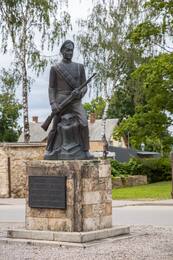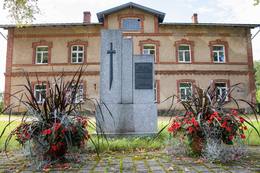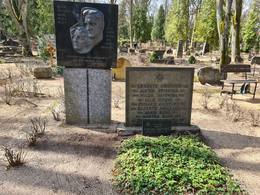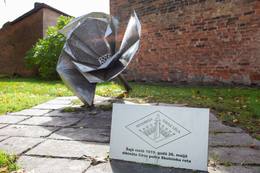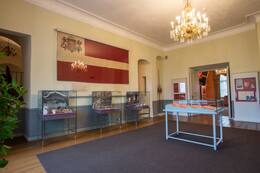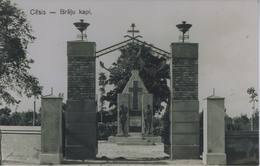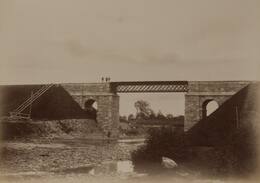Cėsių pulko moksleivių kuopa
I Nepriklausomybės karai
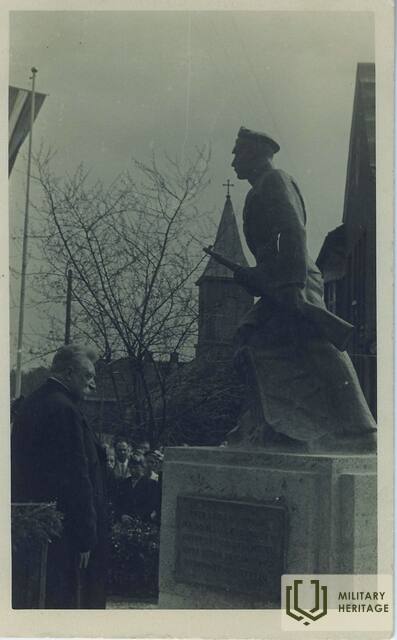
Cėsių pulko mokyklinė kuopa buvo karinis dalinys, kuris buvo suformuotas iš Valmieros ir Cėsių mokyklų jaunuolių 1919 m. gegužės ir birželio mėn. Cėsių mūšio išvakarėse. Kuopa dalyvavo Cėsių mūšiuose ir visuose tolesniuose pulko mūšiuose.
1919 m. gegužės 26 d., kai Estijos kariai išlaisvino Valmierą nuo bolševikų, vadovaujant vietos vidurinės mokyklos gimnazijos mokytojui Alfrēdžiui Lukstiniui (vėliau kuopos puskarininkiui), buvo pradėta registruoti mokinius savanorius savisaugos grupei pagal Estijos kariuomenės mokinių kuopos pavyzdį sukurti. Valmieroje kreipėsi apie 70 jaunuolių, pasiruošusių prisijungti prie 2-ojo Cėsių pulko dalinių, kurie iš Rūjienos per Valmierą vyko į Latgalos frontą. Valmieriečių pavyzdžiu apie 40 Cėsių moksleivių taip pat pradėjo burtis į savanorių vyresniųjų mokyklų būrį. Valmieros ir Cėsių moksleivių iniciatyvą aktyviai palaikė Valmieros ir Cėsių vidurinių mokyklų direktoriai Ludvigs Adamovičs ir Longins Ausējs.
Valmieros ir Cėsių jaunimo susivienijimas įvyko birželio 5 dieną, buvusios Cėsių vokiečių progimnazijos patalpose Dārza gatvėje. Mokiniai, iš viso 108 žmonės, buvo įrašyti į 2-ojo Cėsių pėstininkų pulko 8-ąją kuopą (kupa ir toliau vadinosi Studentų kuopa), o kuopos vadu buvo paskirtas pirmasis leitenantas Gustavas Grīns. Buvo tikimasi, kad kariniai mokymai prasidės jau kitą dieną, tačiau jau pirmą naktį (birželio 5–6 d.) dalis kuopos karių buvo paskirti į Estijos kariuomenės šarvuotąjį traukinį vietiniais žvalgais. Kiti taip pat gavo šautuvus ir po kelių valandų buvo duotas įsakymas eiti į frontą Mācītājmuižos - Meijermuižos rajone, nes vokiečiai pradėjo puolimą. Po įnirtingų mūšių estų ir latvių kariai buvo priversti palikti Cėsius ir trauktis Liepos (Lodės) ir Raunos link.
Pirmajame mūšyje buvo sužeisti keli studentai, tačiau tą pačią dieną nuo labai rimtos skrandžio žaizdos mirė Edgars Krieviņš iš Valmiera. Per Nepriklausomybės karą kuopa neteko 9 žuvusių ir žuvusių. Edgaras Krieviņš po mirties buvo apdovanotas Lāčplėsio karo ordinu. LKO buvo apdovanotas ir pirmasis kuopos seržantas Alfredas Lukstiņš.
1929 m., artėjant Cėsių kovų ir kuopos 10 metų jubiliejui, buvo įkurta buvusios Cėsių pulko savanorių mokinių kuopos karių į pensiją draugija, kuri aktyviai užsiėmė patriotiniu jaunimo ugdymu. Svarbi asociacijos tradicija siejama su Cėsių pulko mokinių kuopos vėliava. Lėšas vėliavos gamybai paaukojo devynių Šiaurės Latvijos gimnazijų mokiniai ir mokytojai, kurių mokiniai į pulką įstojo 1919 m. Vėliavos projektą nubraižė buvęs kuopos karys ir architektas Kārlis Dzirkalis. Vėliavą pagamino septyni Cėsių valstybinės gimnazijos mokiniai, vadovaujami rankdarbių mokytojos Annos Brincevos. 1929 m. birželio 22 d., Cėsiuose, Didvyrių atminimo dieną, buvo surengtos iškilmingos Cėsių pulko mokinių būrio savanorių kuopos vėliavos pašventinimo pamaldos, po kurių Respublikos Prezidentas Gustavas Zemgals vėliavą įteikė kuopos organizatoriui LKO kavalieriui A. Lukstiniui. Pirmus metus vėliava buvo saugoma Cėsiuose, tačiau 1930 metais pradėta tradicija – buvusios Cėsių pulko mokyklos kuopos vėliava perduota metams saugoti vienoje iš Šiaurės Vidžemės gimnazijų. Nuo tada Švietimo ministerijai sutikus vėliava buvo saugoma: 1930 m. - Valmieroje, 1931 m. - Limbaži, 1932 m. - Mazsalacoje, 1933 m. - Rūjienoje, 1934 m. - Valkoje, 1935 m. - Alūksnė, 1936 m. – Gaujienoje, 1937 m. – Smiltenėje, 1938 m. – vėl Cėsiuose ir 1939 m. – Valmieroje. 1940 metais vėliava paskutinį kartą perduota saugoti Limbažų gimnazijai. 1998 m. Cėsiuose atidarius atnaujintą Pergalės paminklą, atkurta Cėsių pulko mokinių kuopos keliaujančios vėliavos tradicija.
Daugiau informacijos šaltinių
Saulė pakilo nuo kardo: prisiminimų ir dokumentų rinkinys apie Cėsių pulko mokinių kuopą 1919 m. Atsiminimus ir dokumentus spausdinti parūpino Tālis Pumpuriņš. - Cėsis, Cėsių muziejų draugija, 1994. - p. 120.
Juris Ciganovas. Moksleivių kuopa 1919 m. mūšiuose. SARGS.LV 2011 05 31. https://www.sargs.lv/lv/latvijas-neatkaribas-kars/2011-05-31/skolnieku-rota-1919-gada-kaujas
Susijusi laiko juosta
Susijusios vietos
Monument for students of the Cēsis Regiment
The monument to the soldiers of the Cēsis Regiment Students’ Company who died in the Battles of Cēsis is located in the city of Cēsis, near the intersection of Palasta and Bērzaines streets. The construction of the monument was proposed by the Soldiers’ Association of the Cēsis Regiment Students’ Company. The monument was unveiled on 26 May 1938. The monument is based on the idea sketched by artist Jānis Rozenbergs, a former soldier of the company. Placed on a metre-high limestone pedestal, the 1.8-metre copper sculpture of a soldier dressed in a school student’s uniform was created by sculptor Rūdolfs Āboltiņš and coppersmith Jānis Zibens. An owl, a symbol of wisdom and knowledge, lies at the soldier’s feet, squatting on and protecting the books of a student who went to war. The sculpture was demolished during the Soviet re-occupation in 1952. A monument named the Komsomol Flag Bearer by sculptor Kārlis Jansons was erected near its former location in 1957. Placed near its historic site, the restored monument was unveiled on 11 November 1992. At the same time, in 1992, a monument to the Komsomol, which had been erected by the occupation regime, was taken down.
Monument to the students' ornaments at the battlefield
On the side of the Cēsis-Āraiši highway, near the former Livu parish.
A monument dedicated to the ornament of volunteers of the Cēsis Regiment, who took part in the battles of Cēsis in 1919, can be seen.
The monument was unveiled on May 29, 1930 near the former Livu parish.
The project of the monument was developed by the former volunteer of the school ornament K.Dzirkalis, the installation works were performed by A.Sproģis firm in Cēsis.
Bronze details according to the author's drawing were created by M.Pluka, they were cast at V.Minūta's factory in Riga. After World War II, the monument was destroyed.
Restored on June 6, 1989, the authors of the restored monument are sculptors A. Jansons and M. Balttiņa, architect I. Timermanis.
Later, the bronze sword and plate were removed for safety reasons and replaced with wooden parts.
Monument to the first fallen soldier of the Schoolmen's Company, Edgars Krieviņas
Located in the Central Cemetery of Valmiera, near the chapel (Miera Street 1/3, Valmiera)
A soldier of the 8th (Skolnieki) company of the Cēsi regiment, LKOK Edgars Krieviņš (1899-1919), died on June 7 from injuries sustained in the battles of Cēsi on June 6, 1919, when he covered the retreat of the rest of the units when the Landsweer attacked.
Memorial sign at the founding site of the Cēsis Regiment School Company
Located at Leona Paegles Street 1, next to the red brick facade.
The author of the memorial is the artist Solveiga Vasiljeva, and the idea is based on a flower bud motif. According to the artist, it symbolizes the newly formed personalities - students who have to make an important, responsible and harsh decision in their still short life.
In the form of a memorial, the outer petals of the flower bud are made of geometric, sharp corners, in contrast to the gentle, rounded inside of the bud. The height of the memorial is up to 1.5 m. The memorial was unveiled on May 26, 2011 in Valmiera, the place where the orchestra of the Cēsis Regiment was formed in 1919.
The contours of Latvia are made of artificial cobblestones, on which a plate with the flag and text of the Cēsis Regiment Students' Association is placed:
"At this place on May 26, 1919
Cēsis Regiment Student Company was founded "
Cēsis history and art museum in the New Castle of Cēsis
The Cēsis History and Art Museum is located in the very centre of the Old Town of Cēsis, in the New Castle. The museum holds a permanent exhibit of history and interiors named ‘Cēsis, a Symbol of Latvian History’, with two thematic sections: the exhibit ‘Red-White-Red Flag in the History of Cēsis and Latvia’ explains the history of the Latvian national flag from the 13th to 20th centuries, the approved national symbol, the flags of Latvian rifle battalions and the traditions of using national colours during the Latvian War of Independence. The exhibit ‘Cēsis and the Latvian War of Independence’ focuses on the founding of the Cēsis Company in December 1918, the joint battle efforts of Estonians and Latvians in the 1919 Battles of Cēsis, the time when, during the Bermondt Affair, Cēsis served as the temporary capital of Latvia for a short time, as well as the history of the Cēsis Victory Monument. In an escape room named ‘Legends of the Battles of Cēsis’, the participants have one hour to find their way out by solving puzzles, making connections and finding hidden objects. The Cēsis Company, one of the first units of the Latvian Armed Forces, was established on 8 December 1918 in Cēsis Castle by Senior Lieutenant Artūrs Jansons. The museum’s exhibit features a memorial plaque dedicated to the Cēsis Company, unveiled on 8 December 1933 at the Cēsis New Castle, which, at the time, served as the headquarters of the 8th Daugavpils Infantry Regiment and the garrison officers’ club.
Cesis Brothers Cemetery
Located in Cēsis Lejas Cemetery, Lenču Street 15, Cēsis.
One of the most important memorial sites of the First World War and the War of Independence in Cēsis is the Brothers' Cemetery in the Lower Cemetery.
The cemetery is the monument of the Brethren's Cemetery, built in 1927 by the artist and thinker of Cēsis Augustus Julla (1872-1958), dedicated to the soldiers buried in the Brothers' Cemetery from 1915 to 1920.
About 200 soldiers are buried in the Brothers Cemetery of Cēsis Lower Cemetery. Among them, an unknown number of Latvian riflemen and Russian soldiers killed in the First World War, as well as soldiers of German (10), Polish and other nationalities. During the Latvian Liberation War, 22 fallen soldiers of the 5th (2nd) Cēsis Infantry Regiment, as well as 11 freedom fighters who fell in other Latvian army units, were buried in these cemeteries. 2 Estonians, 15 victims of Bolsheviks and also Latvian Red Riflemen are buried in the Brothers' Cemetery.
Railway bridge over Amata
Located in Drabešu parish, Cēsis region, near the recreation place "Meža kaujas".
There is a railway bridge over Amata.
The railway bridge over Amata played a very important role throughout the War of Independence, because on June 5, 1919, the first battle of the Estonian army's armed trains with the Baltic Landesver units took place here. Landeswehr, knowing that an armed train was approaching, nominated a railway bridge and took a position at the Amatas home on the river bank, ready for possible warfare. The bridge over Amata was the border between Estonian forces and the Germans.
Historical evidence of the events at the Amata Bridge has not been preserved. As Latvians did not take part in these events, there are no narratives of their memories, there are memories from Estonian soldiers and other sources. It can be said that this was an Estonian-American joint battle against the Landeswehr, because there was an American officer on the Estonian armored train, who later fought in World War II as well. In general, many future World War II officers and commanders took part in the battles of Cēsis, especially on the German side.
The Estonian armed train arrived in Cēsis on June 2, 1919, a day later went to Ieriķi, where talks took place with the landlord, which was unsuccessful, and on June 5, when the armed train approached the Amata bridge again, a collision with the Germans began. A day later, the armed train also took part in the battles near Cēsis, where it helped the soldiers of the Pupils' Company who were threatened with siege. Although the Germans tried to dismantle the rails to cut off the train's retreat, it managed to retreat across the Rauna bridge.
On the night of June 23, 1919, during the battles of Cēsis, the landesver left Cēsis and retreated to the Amata river line. When they retreated, the Germans burned down the house of the Cēsis Latvian Society and blew up a bridge over Amata.
Susijusi istorija
Neįprasta paminklo Cėsių pulko mokyklinei kuopai istorija
1919 m. Cėsių mūšiuose dalyvavo Cėsių pulko savanorių mokinių kuopa, kuri birželio 5 d. buvusios Cėsių vokiečių progimnazijos patalpose Dārza gatvėje (dabar Bērzaines g. 4) susibūrė kaip kovinis būrys iš 108 Valmieros ir Cėsių mokyklų jaunuolių. Jau naktį iš birželio 5 d. į 6 d., maždaug valandą po vidurnakčio, nuskambėjo aliarmas ir įmonei buvo liepta persikelti į vietą. Kuopa žengė į Mācītājmuiža – Meijermuiža liniją, kuri buvo laikoma svarbiausia mūšio zona.
Paminklas, skirtas Cėsių pulko studentų būriui prie buvusių Līvu parapijos namų
1919 m. Cėsių mūšiuose dalyvavo Cėsių pulko savanorių moksleivių kuopa, kuri birželio 5 d. Cėsių vidurinės mokyklos patalpose buvo suformuota iš 108 jaunuolių iš Valmieros ir Cėsių mokyklų. Jau naktį iš birželio 5 d. į 6 d., maždaug valandai po vidurnakčio, suskambėjo aliarmas ir įmonei buvo liepta persikelti į vietą. Kuopa žengė į Mācītājmuiža – Meijermuiža liniją, kuri buvo laikoma svarbiausia mūšio zona.
Pirmajame mūšyje buvo sužeisti keli studentai, tačiau tą pačią dieną nuo labai rimtos skrandžio žaizdos mirė Edgars Krieviņš iš Valmiera. Birželio 13 d., Valmieros miesto kapinėse, su karine pagyrimu palaidotas. Edgaras Krieviņš po mirties buvo apdovanotas Lāčplėsio karo ordinu.
Cėsių mūšio pradžia, eiga ir pabaiga
Pergalei Cėsių mūšyje buvo lemta tapti lūžiu latvių ir estų kovoje už savo šalies nepriklausomybę. Ši pergalė padarė tašką Andrievo Niedros vyriausybės ir vokiečių generolo Rüdigerio von der Goltzo planams užkariauti Baltijos šalis. Vietoj to Liepojoje savo veiklą atnaujino Laikinoji Latvijos vyriausybė, vadovaujama Kārlio Ulmanio.





